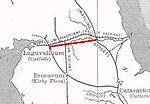Haydon Bridge railway station
1836 establishments in the United KingdomDfT Category F2 stationsFormer North Eastern Railway (UK) stationsNorthern franchise railway stationsPages with no open date in Infobox station ... and 3 more
Railway stations in Great Britain opened in 1836Railway stations in NorthumberlandUse British English from December 2017

Haydon Bridge is a railway station on the Tyne Valley Line, which runs between Newcastle and Carlisle via Hexham. The station, situated 29 miles 68 chains (29.8 mi; 48.0 km) west of Newcastle, serves the village of Haydon Bridge in Northumberland, England. It is owned by Network Rail and managed by Northern Trains.
Excerpt from the Wikipedia article Haydon Bridge railway station (License: CC BY-SA 3.0, Authors, Images).Haydon Bridge railway station
Station Road,
Geographical coordinates (GPS) Address External links Nearby Places Show on map
Geographical coordinates (GPS)
| Latitude | Longitude |
|---|---|
| N 54.9752903 ° | E -2.2472059 ° |
Address
Haydon Bridge
Station Road
NE47 6LL , Haydon
England, United Kingdom
Open on Google Maps







